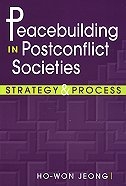|
Peacebuilding in Postconflict Societies: Strategy and Process
|
|
Ho-Won Jeong
|

|

Reconstructing violence-ridden societies poses a great challenge to the international community, and consequently there remains a thirst for new knowledge about peacebuilding. Both conceptually and in terms of practical policy matters, former UN Secretary-General Boutros Boutros-Ghali clearly provided the vision and direction for peacebuilding in his 1992 document An Agenda for Peace, prepared at the request of the Security Council. The definitions and strategies presented by the Secretary-General have greatly influenced our understanding of the peacebuilding enterprise.
Peace operations were originally received with great optimism, hailed as a panacea for overcoming violent social orders and creating a better world. However, the experience in Somalia, Liberia, Haiti, and Bosnia-Herzegovina in the mid-1990s taught us that sustainable peace based on justice can be an illusive goal in the absence of the long-term perspective of structural transformation. Many lessons (learned from mistake in various operations) have been widely discussed, and it is an appropriate time to reflect on them in the hope of advancing the field.
Perhaps chief among these lessons is the recognition that an emphasis on political and military stabilization alone is not sufficient to end a protracted conflict based on ethnic and religious rivalries and opposing political and economic interests. Thus, the discussion of peacebuilding operations in this book goes beyond political and strategic considerations to incorporate the perspectives of civilian security, social rehabilitation, and reconciliation, reflecting on the concerns of the populations that have been victimized by violence.
The examples that I present in the book include both successful and unsuccessful experiences. Also, seeking to link research and policymaking, I examine concepts of policy design, operation, and implementation in terms of their applicability to the real world. It is my hope that the result will be useful to university students, researchers, and policymakers alike.
From the Preface
|
|
